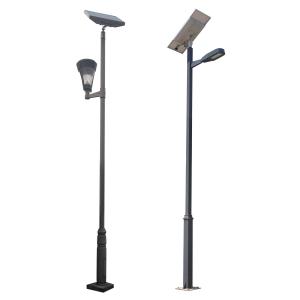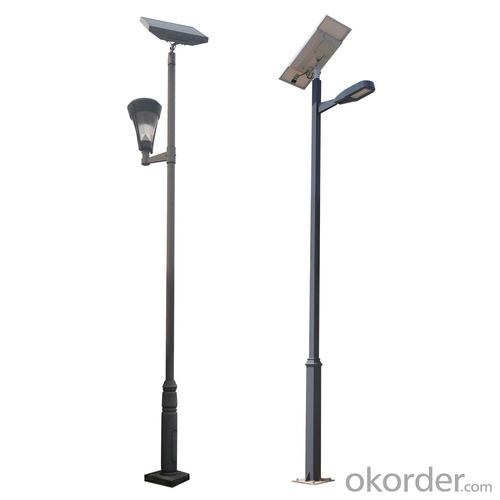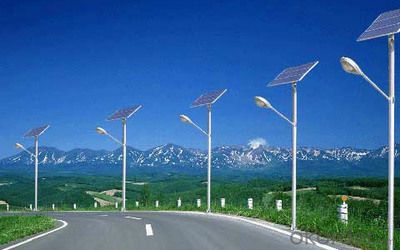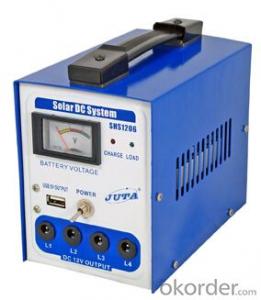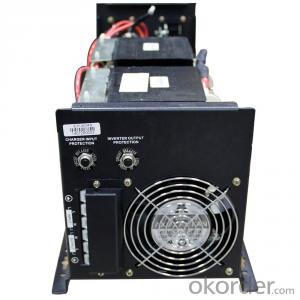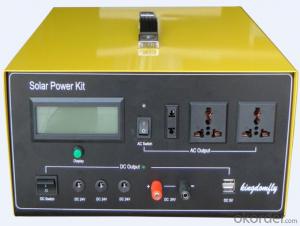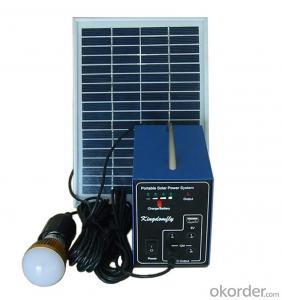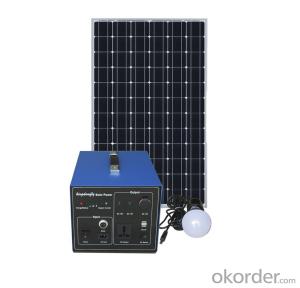Solar Energy Systems Silloth - High Efficiency & New Energy Solar Products
- Loading Port:
- Shanghai
- Payment Terms:
- TT or LC
- Min Order Qty:
- 10 pc
- Supply Capability:
- 5000 pc/month
OKorder Service Pledge
OKorder Financial Service
You Might Also Like
1, Product desciption
Inverter circuits designed to produce a variable output voltage range are often used within motor speed controllers.
The DC power for the inverter section can be derived from a normal AC wall outlet or some other source. Control and feedback circuitry is used to adjust the final output of the inverter section which will ultimately determine the speed of the motor operating under its mechanical load.
Motor speed control needs are numerous and include things like: industrial motor driven equipment, electric vehicles, rail transport systems, and power tools. (See related: variable-frequency drive ) Switching states are developed for positive, negative and zero voltages as per the patterns given in the switching Table.
The generated gate pulses are given to each switch in accordance with the developed pattern and thus the output is obtained.
Solar power is energy from the sun. "Solar" is the Latin word for "sun" and
And Powerful source of energy. Without it, there will be no life.
Solar energy is considered as a serious source of energy for many years
of the vast amounts of energy that is made freely available, if harnessed by modern technology.
A magnifying glass can be used to heat up a small amount of water.
The short piece of copper tube is sealed at one end and filled with water.
And magnifying glass is then used to warm up the pipe.
Using more than one magnifying glass will increase the temperature more rapidly.
2, Features of the product
Inverters convert low frequency main AC power to higher frequency for use in induction heating.
To do this, AC power is first rectified to provide DC power. The inverter then changes the DC power to high frequency AC power. Due to the reduction in the number of DC Sources employed, the structure becomes more reliable and the output voltage has higher resolution due to an increase in the number of steps so that the reference sinusoidal voltage can be better achieved.
This configuration has recently become very popular in AC power supply and adjustable speed drive applications. This new inverter can avoid extra clamping diodes or voltage balancing capacitors. There are three kinds of level shifted modulation techniques, namely: 1,High and stable conversion efficienly based on over 4 years professional experience
2 ,High reliability with guaranteed +/-10% output power tolerance
3,Proven materials,tempered front glass,and a sturdy anodized aluminum frame allow modules to operate reliably in multiple mountily configurations
4,Combination of high efficicncy and attractive appearance
The first thing to figure out is the length of road in need of street lights.
This can be a small entrance road only a couple hundred of feet long to miles of streets through an area. Does the area currently have any type of lighting available.
What is the reason for needing street lights in this area
Is the electrical grid already nearby or would you need to call in the power company to bring in electrical lines.
If the electric needs to be brought to the area, how much is this going to cost? Depending on how far the grid electric is from the location of the needed lighting, this can be quite expensive.
How much lighting is needed on the street? Do the lights need to be dark sky compliant.
Do the street lights need to run from dusk to dawn or for only a specified number of hours at night.
Are the street lights able to dim in the middle of the night and still provide enough lighting.
These questions need to be answered before you can decide on how many lights you will need to complete the project.
3, Detailed Specification
| ||||||||||||||||||||||||||||||||||||||||||||||||
4, Product Image
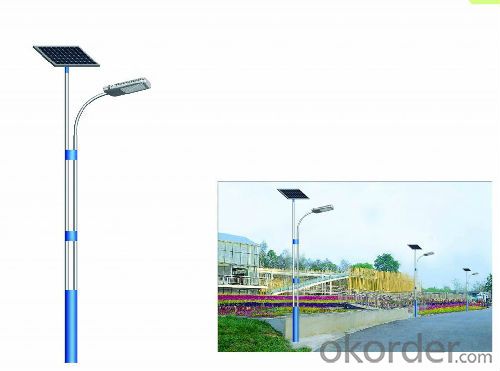
- Q: Can solar energy systems be used in areas with high rainfall?
- Yes, solar energy systems can be used in areas with high rainfall. While excessive cloud cover and rain may reduce the efficiency of solar panels, they can still generate electricity even in such conditions. In fact, some solar panels are designed to work optimally in diffused light, making them suitable for areas with frequent rainfall. Additionally, advancements in solar technology and battery storage systems have made it possible to store excess energy during sunny periods for use during rainy days, ensuring a continuous power supply.
- Q: Can solar energy systems be used in rural areas without access to the power grid?
- Yes, solar energy systems can be used in rural areas without access to the power grid. In fact, solar energy is an ideal solution for off-grid communities as it provides a reliable and sustainable source of electricity. Solar panels capture sunlight and convert it into usable electricity through photovoltaic technology. This electricity can be used to power lights, appliances, and other electrical devices in homes, schools, healthcare facilities, and businesses. One of the main advantages of solar energy systems in rural areas without access to the power grid is their independence from traditional utility companies. These systems can operate autonomously, allowing communities to generate their own electricity without relying on external power sources. This is particularly beneficial in remote areas where extending power lines from the grid can be costly and impractical. Solar energy systems also have a long lifespan and require minimal maintenance, making them suitable for rural areas with limited resources and technical expertise. Additionally, solar panels produce clean energy, reducing reliance on fossil fuels and minimizing the environmental impact. Furthermore, solar energy systems can be combined with energy storage solutions, such as batteries, to store excess electricity generated during the day for use at night or during periods of low sunlight. This ensures a continuous power supply even without direct sunlight. Overall, solar energy systems are a viable and sustainable solution for rural areas without access to the power grid. They provide reliable electricity, reduce dependence on fossil fuels, and offer long-term cost savings.
- Q: Can solar panels be installed on different types of roofs?
- Yes, solar panels can be installed on different types of roofs, including pitched roofs, flat roofs, metal roofs, and concrete tile roofs. The specific installation method may vary depending on the roof type, but with proper design and mounting equipment, solar panels can be successfully installed on various roof surfaces.
- Q: Can solar energy systems be used in powering agricultural irrigation systems?
- Certainly, agricultural irrigation systems can be powered by solar energy systems. As a matter of fact, solar energy is gaining popularity in the agricultural industry due to its numerous advantages. To begin with, solar energy is a clean and renewable source of power, which aids in reducing greenhouse gas emissions and combating climate change. This is especially crucial in agriculture, where conventional power sources like diesel generators contribute to air pollution. Furthermore, solar energy systems are simple to install and maintain. They typically consist of solar panels, an inverter, and a battery storage system. These components can be installed on rooftops, open fields, or even on solar trackers to maximize exposure to sunlight. Once installed, solar energy systems require minimal upkeep, resulting in reduced operational expenses for farmers. Moreover, solar energy systems are particularly well-suited for powering agricultural irrigation systems. Irrigation systems often require a constant and dependable energy source to pump water from wells, rivers, or reservoirs to the fields. Solar energy can fulfill this need for consistent power supply, particularly in sunny regions with high irrigation demands. Additionally, solar energy systems can be combined with energy storage solutions like batteries. This enables farmers to store surplus energy generated during the day and utilize it during periods of low sunlight or at night, ensuring uninterrupted power supply for irrigation systems. Furthermore, solar-powered irrigation systems can prove to be more cost-effective in the long run. Although the initial investment for installing solar panels and associated equipment may be higher compared to traditional power sources, the operating costs are significantly lower. Once the solar energy system is in place, farmers can benefit from free energy from the sun, reducing reliance on expensive fossil fuels or grid electricity. To sum up, solar energy systems are a feasible and sustainable choice for powering agricultural irrigation systems. They offer environmental advantages, are easy to install and maintain, and can provide a reliable and cost-effective energy supply for farmers.
- Q: How do solar energy systems affect air pollution?
- Solar energy systems have a positive impact on air pollution as they generate electricity without emitting any harmful greenhouse gases or pollutants. By replacing traditional fossil fuel sources, solar energy helps to reduce air pollution, improve air quality, and mitigate climate change.
- Q: Can solar energy systems be used for large-scale power generation?
- Yes, solar energy systems can be used for large-scale power generation. Advances in technology and decreasing costs have made it increasingly feasible to deploy solar panels on a larger scale, such as solar farms or utility-scale solar power plants. These systems utilize multiple solar panels to capture sunlight and convert it into electricity, which can then be integrated into the grid to meet the power needs of a significant number of homes, businesses, or even entire communities. Additionally, the scalability of solar energy systems allows for their implementation in various geographical locations, making them a viable option for large-scale power generation worldwide.
- Q: Can a solar energy system be used to charge electric vehicles?
- It is indeed possible to utilize a solar energy system for the purpose of charging electric vehicles. The sun's rays are harnessed by solar panels, also referred to as photovoltaic (PV) panels, to generate electricity. This electricity can then be employed to charge the batteries of electric vehicles. The PV panels capture sunlight and convert it into direct current (DC) electricity. Subsequently, an inverter is used to transform this DC electricity into alternating current (AC) electricity, which aligns with the charging requirements of electric vehicles. By establishing a link between the solar energy system and an electric vehicle charging station, the solar-generated electricity can directly charge the vehicle's battery. This renewable energy source not only diminishes the dependence on fossil fuels but also aids in reducing the emission of greenhouse gases associated with transportation. Moreover, any surplus electricity generated by the solar panel system during daylight hours can be stored in batteries or returned to the grid for future use, guaranteeing a continuous and sustainable power supply for charging electric vehicles.
- Q: Can solar energy systems be used for powering medical facilities or clinics?
- Medical facilities or clinics can utilize solar energy systems to power their operations. Solar energy, obtained through solar panels, is a sustainable and renewable power source. Sunlight is converted into electricity by these panels, which can then be used to operate various electrical appliances and equipment in medical facilities. The utilization of solar energy systems in medical facilities offers numerous benefits. Firstly, it reduces dependence on traditional grid electricity, which may be unreliable or inaccessible in certain areas. Solar energy systems provide a consistent and independent power source, ensuring uninterrupted functioning of medical facilities, even during power outages or in remote locations. Secondly, solar energy systems are environmentally friendly. Medical facilities typically contribute to significant greenhouse gas emissions due to their reliance on fossil fuels for electricity generation. By transitioning to solar energy, medical facilities can considerably decrease their carbon footprint and contribute to a cleaner and healthier environment. Additionally, solar energy systems can help lower operational costs for medical facilities. Although the initial installation cost of solar panels may be higher, they have a long lifespan and require minimal maintenance. Over time, the electricity generated by solar panels can offset or even eliminate the need to purchase electricity from the grid, resulting in substantial cost savings. Furthermore, solar energy systems can be combined with energy storage solutions, such as batteries, to ensure a continuous and reliable power supply. This is particularly crucial for medical facilities that require uninterrupted power for critical equipment and life-saving procedures. In conclusion, solar energy systems offer a feasible and sustainable solution for powering medical facilities or clinics. They provide an independent and consistent power source, contribute to a cleaner environment, and can help reduce operational expenses. By harnessing solar energy, medical facilities can enhance their resilience, sustainability, and ability to provide high-quality healthcare services.
- Q: How do solar energy systems affect the electrical wiring of a building?
- Solar energy systems can have an impact on the electrical wiring of a building. When solar panels are installed, they need to be connected to the existing electrical system. This typically involves adding a new electrical panel or inverter to convert the DC power from the solar panels to AC power that can be used in the building. Additionally, solar energy systems may require the installation of new wiring to connect the panels to the electrical panel. However, with proper installation and integration, solar energy systems should not negatively affect the electrical wiring of a building.
- Q: Can solar energy systems be used for powering streetlights?
- Yes, solar energy systems can be used for powering streetlights.
Send your message to us
Solar Energy Systems Silloth - High Efficiency & New Energy Solar Products
- Loading Port:
- Shanghai
- Payment Terms:
- TT or LC
- Min Order Qty:
- 10 pc
- Supply Capability:
- 5000 pc/month
OKorder Service Pledge
OKorder Financial Service
Similar products
Hot products
Hot Searches
Related keywords
